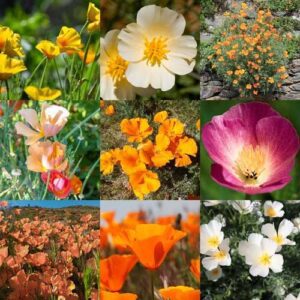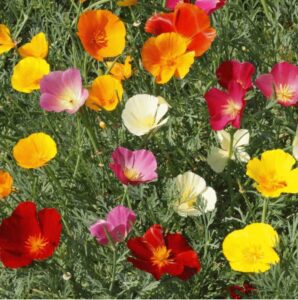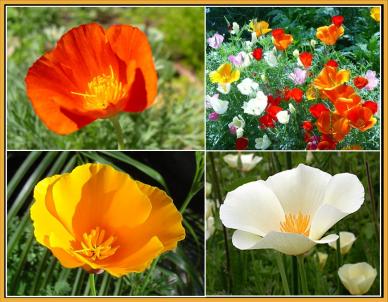
Poppy flowers are not only beautiful additions to any garden but also carry cultural and symbolic significance. Growing poppy flower seeds can be a delightful experience, bringing a burst of color and charm to your outdoor space. In this comprehensive guide, we’ll take you through the process of successfully growing poppy flower seeds, from selecting the right seeds to caring for your plants as they thrive and blossom.

Understanding Poppy Flower Seeds
Before you start planting poppy flower seeds, it’s essential to understand the unique characteristics of these flowers and their seeds.
Selecting the Right Seeds

When selecting poppy flower seeds, consider the variety of poppy you want to grow and choose seeds that are suitable for your climate and growing conditions. Poppies come in various colors, including shades of red, pink, orange, and white, so select seeds that align with your garden design preferences. Look for high-quality seeds from reputable suppliers or nurseries to ensure successful germination and healthy growth.

Understanding Germination Requirements
Poppy flower seeds have specific germination requirements that must be met for successful growth. They prefer well-drained soil, ample sunlight, and moderate temperatures for optimal germination and establishment. Providing these conditions will help ensure higher germination rates and healthier plants.

Planting Poppy Flower Seeds
Now that you have selected your poppy flower seeds, it’s time to get planting! Follow these steps to ensure successful germination and healthy growth of your poppy plants:

Step 1: Preparing the Soil
Choose a sunny location in your garden with well-drained soil for planting poppy flower seeds. Remove any weeds, rocks, or debris from the planting area and loosen the soil to a depth of about 6 to 8 inches. Incorporate organic matter, such as compost or aged manure, to improve soil fertility and structure.

Step 2: Sowing the Seeds
Sow the poppy flower seeds directly into the prepared soil at a depth of about ¼ inch. Space the seeds evenly, leaving about 8 to 10 inches between rows to allow room for growth and airflow. Gently press the seeds into the soil surface and water lightly to ensure good seed-to-soil contact.

Step 3: Watering and Maintenance
Water the planted seeds thoroughly immediately after sowing to settle the soil and provide moisture for germination. Keep the soil consistently moist but not waterlogged during the germination period, which typically takes about 10 to 14 days. Once the seedlings emerge, water them regularly, especially during dry spells or hot weather.

Step 4: Providing Support
As poppy plants grow, they may benefit from support to prevent them from bending or flopping over. Install stakes or trellises around the plants to provide support and keep them upright as they mature and develop.

Caring for Poppy Seedlings
Once your poppy seedlings have emerged and established themselves, they will require minimal care to thrive and flourish. Follow these essential care tips to ensure the health and vitality of your poppy plants:
Watering
Water your poppy plants regularly, ensuring that the soil remains evenly moist but not waterlogged. Water at the base of the plants to avoid wetting the foliage, which can increase the risk of fungal diseases.

Thinning
If the poppy seedlings are overcrowded, thin them out to allow adequate spacing between plants. This will prevent competition for nutrients and airflow, promoting healthier growth and better blooms.
Mulching
Apply a layer of organic mulch, such as straw or shredded bark, around your poppy plants to conserve moisture, suppress weeds, and regulate soil temperature. Maintain a layer of mulch about 2 to 3 inches thick, taking care to keep it away from the base of the plants to prevent rot.

Fertilizing
Fertilize your poppy plants sparingly with a balanced fertilizer to provide essential nutrients for growth and flowering. Apply fertilizer according to the manufacturer’s instructions, being careful not to over-fertilize, which can lead to excessive foliage growth at the expense of blooms.
Harvesting and Enjoying Your Poppy Flowers
As your poppy plants mature and begin to flower, you’ll be rewarded with an abundance of colorful blooms that add beauty and elegance to your garden. Harvest the poppy flowers when they are fully open and at their peak freshness for the best color and longevity. To harvest, simply snip the flowers from the plant with clean, sharp scissors or shears, leaving some stems intact to encourage continued flowering.
Conclusion
Growing poppy flower seeds is a delightful and rewarding experience that allows you to cultivate a garden filled with vibrant and captivating blooms. By following the steps outlined in this guide and providing proper care and maintenance, you can ensure the successful growth of poppy plants from seeds to maturity. Whether you’re a seasoned gardener or a novice enthusiast, growing poppies offers a gratifying journey that culminates in a stunning display of color and elegance to enhance your outdoor space.
Hudgle California Poppy Flower Color Flower Seeds For Home Gardening Planting – 20 Seeds Pack
About this item
- Sold By Hudgle Greens Provide 100% Best Quality Seeds Of Flower Plants.
- Hudgle Registered Brand Product
- It Is The State Flower Of California.
- 20 Seeds In Pack
- Sow and Grow Fresh Healthy Seed in Your Garden Perfect for Home & Terrace Gardening High Germination Seeds
- You Get The Flowers Under 75 Days
- For More Information About California Poppy Flower Mix Color Read The Description.



